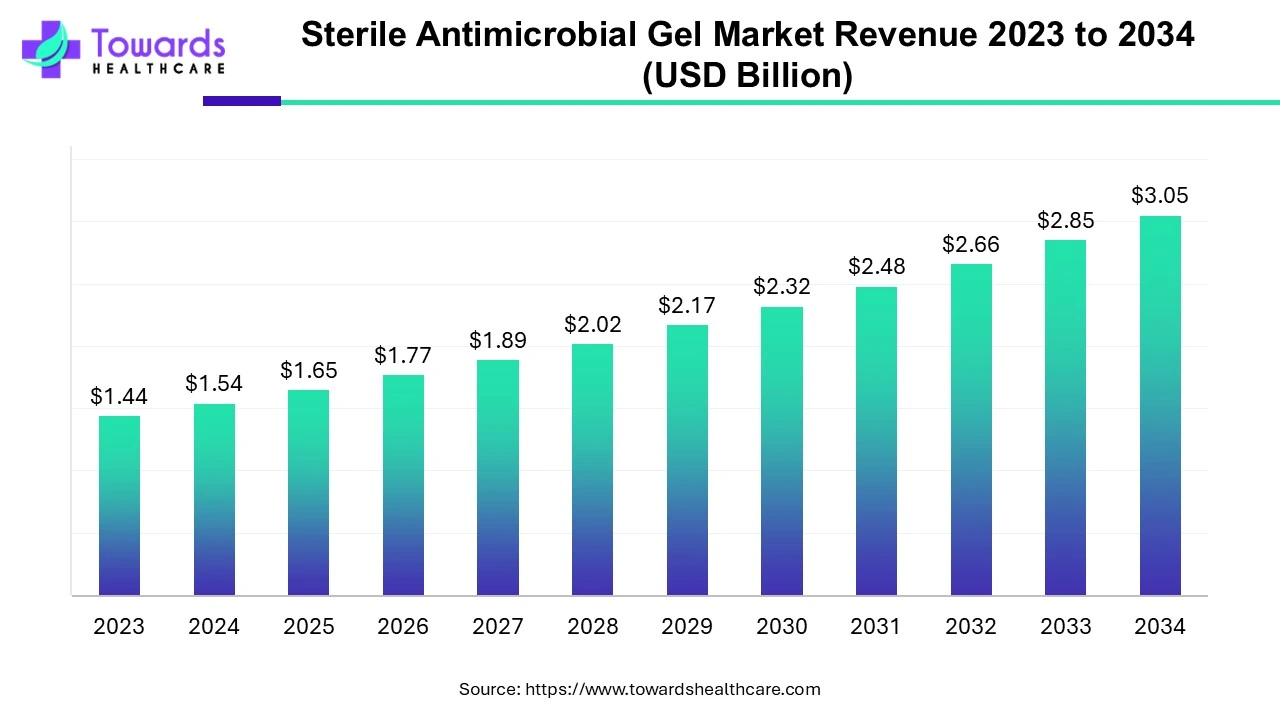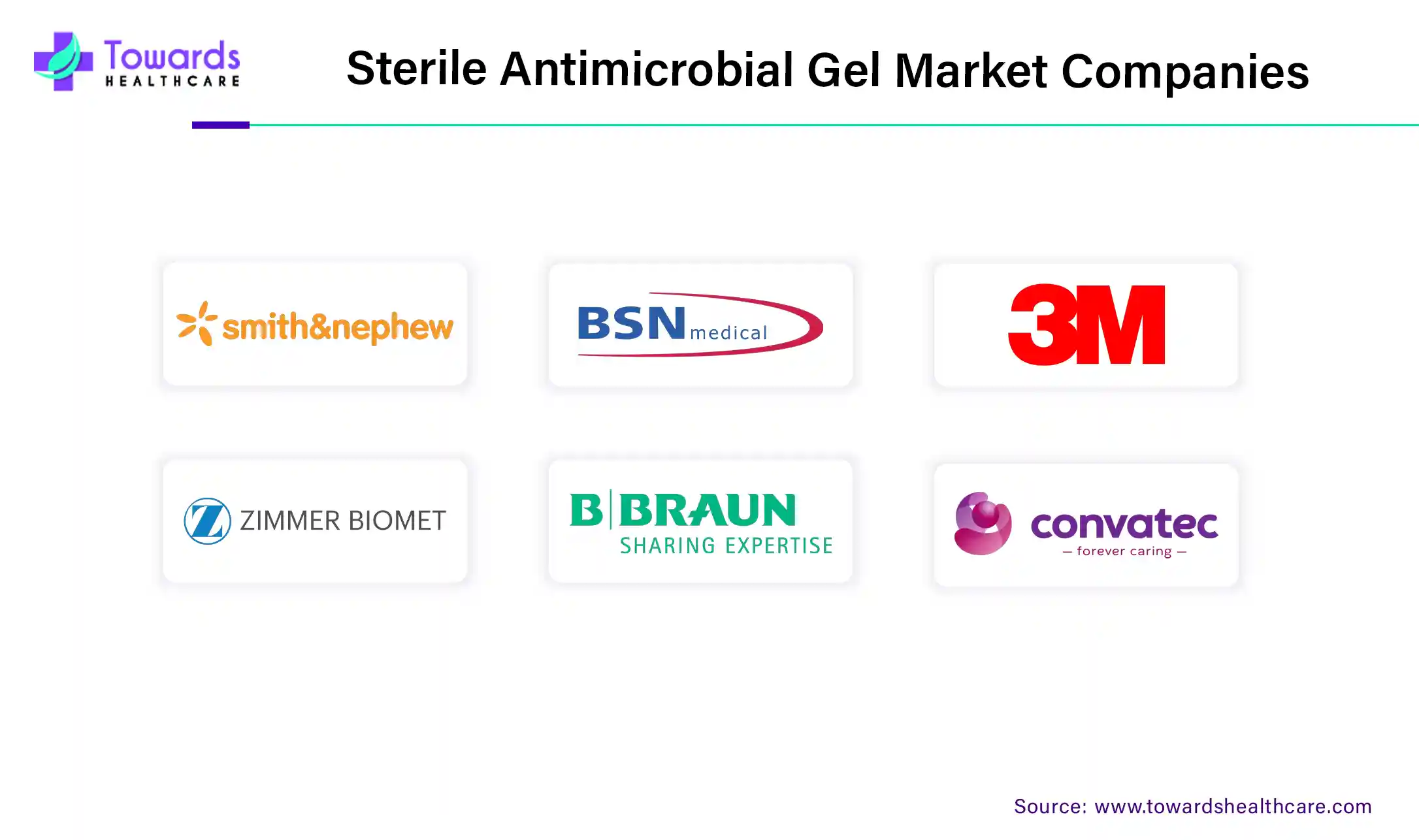December 2024


Principal Consultant

Reviewed By
The global sterile antimicrobial gel market was estimated at US$ 1.44 billion in 2023 and is projected to grow to US$ 3.05 billion by 2034, rising at a compound annual growth rate (CAGR) of 7.05% from 2024 to 2034. The increased demand for sterile antimicrobial gel is due to its widespread applications to reduce post-surgical, bacterial, or skin infections during chronic skin ulcers, traumatic wounds, or post-operative wounds along with its ideal properties including biocompatibility, wound healing, and disinfection.

One of the effective antimicrobial agents is silver which plays a vital role in treating burn wounds. Scientific research is making efforts on silver nanoparticles to develop antimicrobial gel formulations for topical uses and therapeutics. The sterile antimicrobial gels combine several chemical ingredients with a controlled pH and offer a high osmolarity environment. They also help to reduce superficial surgical site infections which usually start in the operating room. The antimicrobial natural hydrogels are widely used as biomedicines in drug delivery, tissue scaffolding, and wound dressings and they lower the risks of microbial infections.
Several regulatory authorities and government measures are making efforts to establish trust and authenticity in the sterile antimicrobial gel market. According to the 2023 progress report by the Global AMR R&D Hub and WHO, the G7 finance and health ministers were committed to ensuring access to essential antibiotics, and strengthening research and development in antimicrobial resistance (AMR) to bring novel antibacterials to market for addressing public health needs in 2021 and 2022. According to the National Library of Medicine, research is in progress for developing wound-healing products based on natural compounds, stem cells, and microRNA-based biopolymers in the USA, European, and Asia markets.
The FDA proposed premarket approval application requirements for medically important antimicrobial products acting as protectants or preservatives and raising a high level of antimicrobial resistance concern. There must be compliance with PMA requirements of the Federal Food, Drug, and Cosmetic Act (FD&C Act). A solid wound dressing, other wound dressings, and liquid wound washes containing antimicrobials or other chemicals are ideal for maintaining appropriate moisture balance within the wound, and they cover or protect a wound.
Medically essential antimicrobials are inserted in those dressings to reduce microbial growth within them while using or to offer an antimicrobial barrier to microbial entry through those wound dressings. Patients are the potential end users of these formulations and of the liquid wound washes that are water-based solutions for removing debris from external wounds. The FDA identifies the benefits and risks associated with medically important antimicrobial products related to adverse tissue and immunological reactions, transmission of pathogens and parasites, delayed wound healing, infection, etc.
The antimicrobial products present in the form of gels, creams, or ointments might be associated with some risks including erythema, irritation, wound inflammation, or hemolysis due to unwanted tissue response to the materials, leachable, or extractable in wound dressings or liquid wound washes. If the animal sources get contaminated due to improper processing, or viral inactivation of the animal-derived materials, then there can be transmission of parasites and pathogens. Inadequate storage and packaging of the materials can result in degradation of the products reducing their shelf life. A degradation of the products can also modify their composition and characteristics which can ultimately cause harm to the patients. Due to improper sterilization processing, unsafe methods of manufacturing, failure in the effectiveness of preservatives can result in the loss of tensile strength and changed pH leading to infection or adverse tissue reaction. These challenging factors greatly contribute to strengthening the safety and reliability of the sterile antimicrobial gel market.
Asia Pacific is the fastest-growing region in the sterile antimicrobial gel market due to the growing population, increased shift towards medical tourism, and the rising incidence rates of traumatic wounds. China is leading with its huge population, technological advancements, and the need for medical products and services. Germany also contributes to the market’s growth with the expansion of antimicrobial wound gel products for the betterment of people. The leading market players are aiming to expand their product lines for the growth of sterile antimicrobial gel products in the market. Strategic activities of market participants, market developments with new product launches, highest investments, mergers and acquisitions, contractual agreements, and collaboration with other organizations are responsibly expanding their global footprint. The companies are making efforts to provide cost-effective items to expand and survive in this competitive market.
North America dominated the sterile antimicrobial gel market in 2023 due to the large elderly population, increased rates of diabetes and burns, traffic accidents, etc. In the European region, the United Kingdom leads in the sterile antimicrobial gel market with its medical-oriented health services and solutions. Manufacturers are strategically minimizing the operational costs that are becoming key business tactics for the global market. Businesses are focusing on offering benefits to their clients and increasing the market sector. The UK-based Smith & Nephew Plc company is a member of the FTSE 100 index and it is traded on the London Stock Exchange. A novel technique for regenerating tissue to repair the rotator cuff in the shoulder was developed by Smith & Nephew in March 2019 by acquiring the Rotation Medical Inc. The companies are majorly investing in research and development of medically trustful products and services. According to the NCBI study in 2020, approximately 40 to 50 million medical procedures are performed annually in the United States. Furthermore, there are rising incidence rates of the hospital-acquired medical infections and the rising surgical procedures.
Based on products, the sterile antimicrobial gel market is divided into silver dressings, povidone-iodine dressings, PHMB dressings, and others. The silver wound dressing segment accounted for the largest market share in 2023 by being an ideal antimicrobial wound care dressings that use silver as the active element. There are many forms of silver wound dressings such as foam, gauze, hydrocolloid, and alginate dressings. They are very beneficial in treating chronic wounds like pressure ulcers and diabetic foot ulcers that are sensitive to infection.
The antimicrobial wound dressings for chronic wounds segment led the market in 2023 by treating pressure ulcers, lower extremity ulcers, etc. Due to high morbidity and mortality rates of chronic wounds with increased public health concerns, the demand and need are also raising the expansion of these products.
The hospitals segment led the market in 2023 due to the recent tools and technologies for diagnosis, wound monitoring, and quick healing solutions of the hospitals. Specialized home care services and wound care departments of the hospitals in recent years havev putting their efforts in the management and inspection of infectious conditions of patients.

By Product
By Application
By Region
December 2024
September 2024